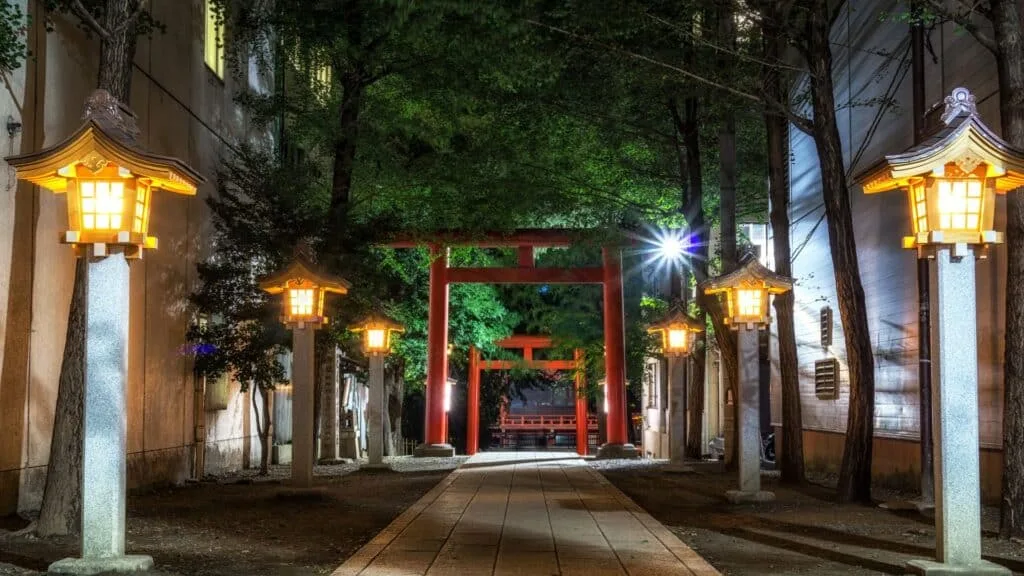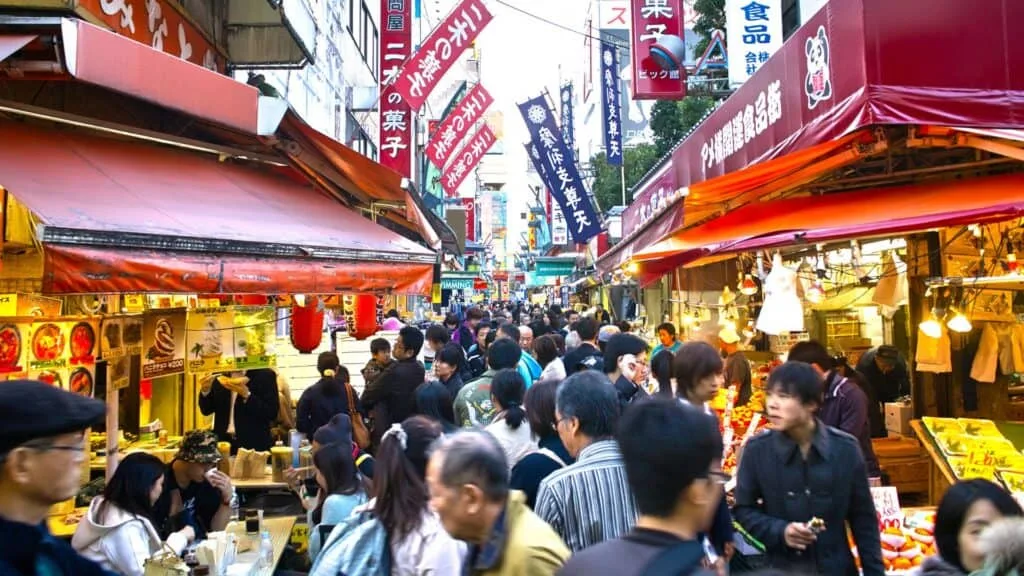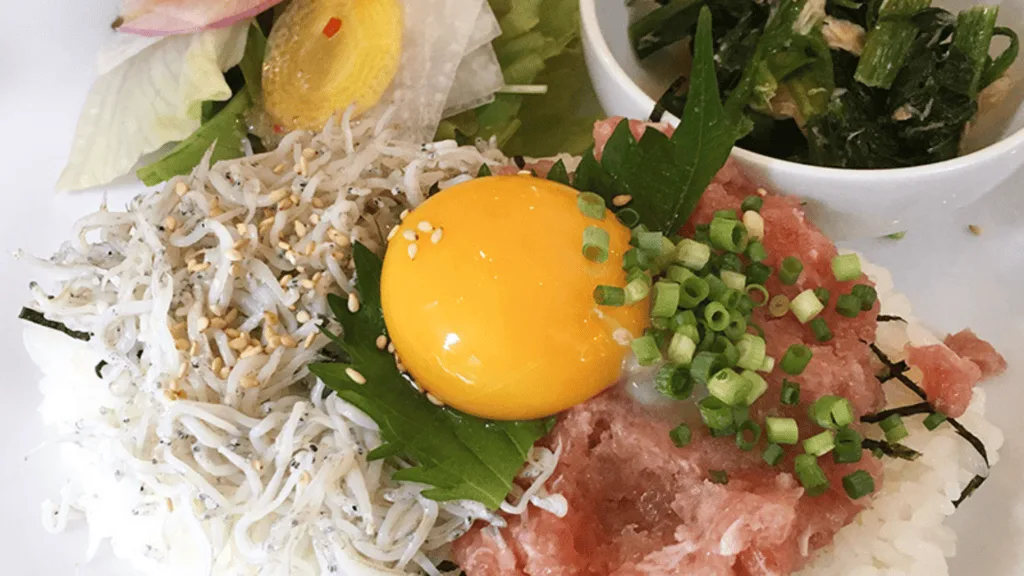Have you ever heard of the Ueno neighbourhood in Tokyo? Are you considering a visit to this unique area or even planning to stay in Ueno, and wondering about the best things to do, places to visit, and restaurants to check out?
Tokyo boasts numerous neighbourhoods and areas to explore. Alongside renowned districts like Shinjuku, Shibuya, and Harajuku, there are many captivating locales in Tokyo waiting to be discovered. If you’re keen on exploring a local neighbourhood and uncovering hidden gems, Ueno could be an excellent choice. In this guide to the Ueno area, let’s delve into what Ueno has to offer, including attractions, dining options, accommodation choices, and some lesser-known treasures in the vicinity.
Getting to Know Ueno

Ueno is a favoured tourist destination in Tokyo, renowned for its museums, picturesque park famed for cherry blossoms, and various exciting activities. The Ueno district draws both tourists and locals alike for weekend leisure, boasting several remarkable attractions such as the Tokyo National Museum, the Tokyo Metropolitan Museum of Art, the renowned Ueno Park, Ueno Zoo, and a plethora of other recreational opportunities suitable for both adults and children.
Every spring, thousands of people flock to Ueno Park to enjoy picnics under the cherry blossoms, making it one of Tokyo’s most sought-after spots for hanami, or cherry blossom viewing.
Additionally, visitors can explore various shrines and local commercial areas, immersing themselves in Japanese culture. Situated in the Taito ward in eastern Tokyo, Ueno is also considered the shitamachi, or traditional downtown area of Tokyo, dating back to the Edo era. The neighbourhood exudes historical significance, evident to visitors as they stroll through its streets.
Must-Go Spots in Ueno
Ueno Park

Ueno Park, Japan’s inaugural public park, stands out as one of the city’s premier attractions. Spanning 53,000 square metres, the park houses Ueno Zoo, Shinobazu Pond, and several museums, providing ample opportunities for a full day of exploration. The diverse activities cater to guests of all ages, ensuring a family-friendly and engaging experience.
During April and May, the park transforms into a stunning panorama of pink hues as cherry blossoms bloom, attracting throngs of visitors eager to bask in the beauty of sakura.
Find out more about Ueno Park here on Google maps.
Hanazono Inari Shrine

Hanazono Inari Shrine is situated within Ueno Park. Renowned as a matchmaking power spot, it draws those seeking to enhance their romantic fortunes. Its striking entrance, marked by red Senbon Torii, or thousand torii gates, leaves a lasting impression. A multitude of torii gates stand sentinel at the entrance, creating an impressive pathway. Conveniently located within Ueno Park, it offers easy access for visitors.
Find out more about Hanazono Inari Shrine here on Google maps.
Ameyoko: Everyone’s Favourite Shopping Street

Ameyoko, Ueno’s bustling shopping district, holds a prominent position as one of the city’s iconic destinations, attracting large crowds, particularly on weekends. Originating as a black market during WWII, Ameyoko has since transformed into a vibrant shopping area renowned for its affordable prices and extensive variety of merchandise. From fresh produce to apparel and cosmetics, an array of goods can be found here.
Additionally, numerous food vendors line Ameyoko, offering treats such as matcha ice cream from Cha no Kiminoen or dorayaki, a traditional Japanese confection filled with red bean paste, for those with a sweet tooth.
Find out more about Ameyoko here on Google maps.
Ueno Zoo

Ueno Zoo boasts a diverse collection of animals unique to Japan, including the Yezo deer from Hokkaido and the charming Japanese squirrel. A visit to Ueno wouldn’t be complete without seeing these rare species. Furthermore, the zoo is home to Riri, Shinshin, and Shanshan, Tokyo’s beloved pandas, whose adorable antics and endearing expressions never fail to captivate visitors.
The popularity of these furry residents has led to a proliferation of panda-themed merchandise and food items available for purchase in and around Ueno Zoo, making for delightful gifts and souvenirs.
Find out more about Ueno Zoo here on Google maps.
Bentendo Temple at Shinobazu Pond

Bentendo Temple, nestled in Ueno Park, is a Buddhist temple dedicated to Benzaiten, the goddess associated with education, art, wealth, and matchmaking. Perched amidst Shinobazu Pond, the temple exudes an otherworldly charm, its colourful hexagonal tower visible from afar.
Find out more about Bentendo Temple here on Google maps.
Tokyo National Museum: The Best Place to Learn about Japan’s History and Art

Art and history enthusiasts shouldn’t miss the Tokyo National Museum, situated within the grounds of Ueno Park. Housing an extensive collection of over 110,000 artworks and cultural artefacts, a visit to this museum provides a comprehensive insight into Japanese artistry.
Among its exhibits are samurai armour, intricately painted folding screens, and Ukiyo-e Japanese woodblock prints. The museum also showcases art and historical items from various other Asian countries.
Find out more about Tokyo National Museum here on Google maps.
Takeya: A Popular Shopping Mall

Takeya, a sprawling retail complex spanning eight buildings, offers a diverse selection of Japanese brands and products. Unlike Ameyoko, Takeya provides a distinctive shopping experience, both in terms of its layout and the merchandise available. Each building features its own theme, facilitating easy navigation for shoppers.
Takeya also offers complimentary WiFi and operates as a duty-free store, making it a convenient and popular destination for international travellers holding foreign passports.
Find out more about Takeya here on Google maps.
Kurand Sake Market: Taste Authentic Japanese Sake

The Kurand Sake Market in Ueno offers an unlimited tasting menu featuring around one hundred types of sake brewed in various regions of Japan. It’s an excellent opportunity for those interested in Japanese sake but unsure where to start, providing a chance to sample a variety of flavours in a relaxed setting. The venue also hosts events where customers can meet and chat with brewers casually to learn more about the sake craft. Reservations can be made online in advance or on the day of visit, but please note that spots are limited.
Find out more about Kurand Sake Market here on Google maps.
The National Museum of Western Art

Established in 1959, this museum revolves around the Matsukata collection, which includes impressionist paintings and sculptures by Auguste Rodin. These masterpieces, spanning from the Renaissance to the twentieth century, remain on display to this day. The museum itself is a significant structure designed by renowned French architect Le Corbusier. Erected after WWII, it symbolises France’s enduring ties with Japan, offering everyday Japanese citizens the chance to observe and appreciate western art and culture.
Find out more about The National Museum of Western Art here on Google maps.
Shitamachi Museum

The Shitamachi Museum was founded as a historical landmark to preserve and educate about shitamachi culture. Shitamachi, which literally translates to “downtown,” refers to the lowlands where residents lived. The museum’s first floor recreates a street from that era, allowing visitors to wander through residences and businesses. The second floor offers a deeper insight into shitamachi life through preserved records and household goods, including exhibits on children’s toys.
Find out more about Shitamachi Museum here on Google maps.
Kyu Iwasaki-Tei Gardens

Situated within the grounds of Ueno Park are the Kyu Iwasaki-Tei Gardens, once the residence of the Iwasaki family, founders of Mitsubishi and one of Japan’s most influential business families. The gardens feature buildings of various cultural influences, such as a Swiss billiard room, with the main house reflecting Pennsylvania and Jacobean styles.
Find out more about Kyu Iwasaki-Tei Gardens here on Google maps.
Ueno Tosho-gu

Built in 1627 to enshrine Ieyasu Tokugawa (Tosho Daigongen), Yoshimune Tokugawa, and Yoshinobu Tokugawa as deities, the Toshogu Shrine is located in Ueno Onshi Park. Despite experiencing natural disasters and war damage, it has survived since its renovation in 1651, offering a glimpse of full-scale Edo architecture with remnants from the past. Luxuriously adorned with gold leaf, it’s often referred to as the “golden hall,” featuring a peony garden famous for its spring “peony festival.”
Find out more about Ueno Tosho-gu here on Google maps.
Kaneiji

Constructed in 1625 by Tenkai Daimonsho, the Kaneiji Temple initially occupied a vast area centred around present-day Ueno Park. However, during the Boshin War, it suffered damage and much of it was destroyed when the Shogitai Corps of the former Shogunate Army stood in the precincts, leading to the so-called “Ueno War.” Despite confiscation of its land during the Meiji era, it remains one of the Tokugawa family’s temples, housing the mausoleum of six successive Tokugawa shoguns’ generals within its precincts.
Find out more about Kaneiji here on Google maps.
Kaisando

This temple was established in 1534 and is adorned with carvings crafted by renowned artisans from the Edo Period, including Uncho Ishikawa and Shoshu Kanno. The intricately decorated ceiling, in particular, is a sight not to be missed.
Find out more about Kaisando here on Google maps.
Kiyomizu Kannon-dō

Constructed in 1631, this hall serves as a stage for performances. It is said that Enryakuji, a priest of Jiyoku Daishi, erected the Kannon-do at the demon gate of Edo Castle, drawing inspiration from the relationship between Heiankyo and Mt. Hiei, and modelled it after Kiyomizu-dera Temple in Kyoto. In the 7th year of Genroku (1694), it was relocated from Mt. Suribachi in Ueno Park to its present site. The main deity enshrined here is the Senju Kanzeon Bosatsu, originally from Kiyomizu-dera Temple. It’s also revered as a deity for child-rearing, easy childbirth, and nurturing, with the enshrinement of the child-rearing Kannon in Wakison.
Find out more about Kiyomizu Kannon-dō here on Google maps.
Shimura Shoten

A store specialising in chocolate confectionery with lively sales pitches stands out with its distinctive yellow sign. Located in “Ueno Ameya Yoko,” the shop offers chocolates, which are a local specialty. Witnessing the skilful filling of chocolates one after another, leading to a smooth melt-in-the-mouth experience, is a highlight of Ameya Yoko. The store sells a variety of sweets, some of which would individually cost over 2000 yen. Given its daily bustling atmosphere, it’s recommended to relish these treats while immersing yourself in the lively ambiance.
Shitamachi Museum

Until the Meiji and Taisho eras, remnants of Edo lingered in downtown Tokyo. However, the Great Kanto Earthquake of 1923 and wartime devastation in 1945 wiped out much of this history. Post-war, extensive redevelopment took place, culminating in a transformative period during the late 1950s, spurred by the Tokyo Olympics. As modern lifestyles took hold, traditional values began to fade.
In the 1960s, concerns arose over the loss of traditional downtown culture, prompting efforts to preserve its legacy. This led to the establishment of a museum dedicated to safeguarding the area’s rich history for future generations. Generous donations from within and beyond Taito City helped bring this vision to life.
After years of dedication, the Taito City Shitamachi Museum of Folklore opened on October 1, 1980, near Shinobazunoike Pond. The ground floor hosts a life-sized replica of a Taisho-era merchant house and row houses, while the upper floor showcases materials related to Taito City, alongside a toy exhibition corner.
Find out more about Shitamachi Museum here on Google maps.
Flip Japan-Recommended Restaurants in Ueno
Fukumimi Maratan

This authentic Chinese restaurant is just a 2-minute walk from Okachimachi Station and specialises in Chinese “Mala Soup,” a spicy dish made with harusame noodles. Customers can customise their orders by selecting their preferred noodles, toppings, and spice level from a showcase before finalising their choices at the counter. They then wait for their meal to be prepared and served.
Find out more about Fukumimi Maratan here on Google maps.
Uogashi Nihon-Ichi

Uogashi Nihon-Ichi, located just a 4-minute walk from Okachimachi Station, offers high-quality, fresh sushi at affordable prices. The restaurant benefits from its participation in the Tsukiji Market auction, enabling it to offer reasonably priced dishes.
Find out more about Uogashi Nihon-Ichi here on Google maps.
Sha Tom Yum Kung Pochana

Situated along Youth Road Ueno, a bustling shopping strip leading to Okachimachi Station, this Thai restaurant boasts an authentic taste thanks to its Thai chef. Both lunch and dinner times draw crowds of patrons, with the Tom Yum Lunch, a hot and sour shrimp soup served with rice, dessert, and a vegetable salad, being a popular choice.
Find out more about Sha Tom Yum Kung Pochana here on Google maps.
Azuki

Only a short 2-minute stroll from Okachimachi Station, this sukiyaki and shabu-shabu specialty restaurant offers high-quality meat dishes at affordable prices. Notable is the Olive Yumebuta, a dish featuring pork from Kagawa Prefecture’s Shikoku Island, where olives are added to the pigs’ feed. This imparts a rich, sweet flavour with a refreshing umami taste to the meat.
Find out more about Azuki here on Google maps.
Bistro Vingt-Neuf

Located just a minute’s walk from Mikawashima Station, this café specialises in delicious meat dishes, including Wagyu beef, Iberian pork, and Kuro Kuro meat, all priced at 1,000 Yen. The Roast Beef donburi, featuring finely sliced roast beef atop rice, is particularly popular during lunch hours.
Find out more about Bistro Vingt-Neuf here on Google maps.
Iriya Kaigan Shonan Shokudou

A mere 4-minute walk from Ueno Station’s Iriya Gate, this Italian restaurant offers a diverse menu featuring ingredients sourced from Shonan, Kanagawa Prefecture. Known for its mineral-rich soil, this area produces flavourful “Kamakura veggies,” prominently featured in dishes like the Kamakura Yasai Keema Curry, a lunchtime favourite.
Find out more about Iriya Kaigan Shonan Shokudou here on Google maps.
Flip Japan-Approved Accommodation in Ueno
Mimaru Tokyo Ueno East

Situated in Tokyo, within 400 metres of Hozenji Temple and 500 metres of Myojun-ji Temple, MIMARU TOKYO UENO EAST offers accommodation with free WiFi throughout the property. The property is located 1.5 kilometres from Gate of Former Residence of Koda Rohan, 1.5 kilometres from Front gate of Honobo In Kanei-ji Temple, and 1.7 kilometres from Shunsho-in Temple.
The property is 8 kilometres from the city centre and 1.8 kilometres from Tozen-in Temple. The hotel provides guests with air-conditioned rooms equipped with a desk, kettle, microwave, fridge, safety deposit box, flat-screen TV, and a private bathroom with a bidet. Bed linen and towels are provided in the rooms at MIMARU TOKYO UENO EAST. Nearby attractions include Ryukoku-ji Temple, Genryu-in Temple, and Ecute Ueno Shopping Mall. The nearest airport is Tokyo Haneda International Airport, 30 kilometres from MIMARU TOKYO UENO EAST.
Address: 110-0015 Tokyo-to, Taito-ku Higashiueno 4-26-3, Japan
Hotel Resol Ueno

Ideally located in the Taito district of Tokyo, Hotel Resol Ueno is set less than 1 kilometre from Myojun-ji Temple, an 11-minute walk from Ryukoku-ji Temple, and less than 1 kilometre from The Shitaya Shrine. The property offers a 24-hour front desk, luggage storage space, and free WiFi throughout.
Popular attractions nearby include Gate of Former Residence of Koda Rohan, Front gate of Honobo In Kanei-ji Temple, and Ecute Ueno Shopping Mall. A à la carte breakfast is available every morning at the hotel. Nearby points of interest include Saigo Takamori Statue, Atre Ueno Shopping Mall, and Ueno Royal Museum. The nearest airport is Tokyo Haneda International Airport, 30 kilometres away.
Address: 110-0005 Tokyo-to, Taito-ku Ueno 7-2-9, Japan
Sutton Place Hotel Ueno

Attractively situated in the Taito district of Tokyo, Sutton Place Hotel Ueno is located 200 metres from Ecute Ueno Shopping Mall, 300 metres from Front gate of Honobo In Kanei-ji Temple, and 300 metres from Gate of Former Residence of Koda Rohan.
The hotel offers a shared kitchen, shared lounge, and free WiFi throughout the property. Family rooms are available. Nearby attractions include Ryukoku-ji Temple, Atre Ueno Shopping Mall, and Hozenji Temple. The nearest airport is Tokyo Haneda International Airport, 18 kilometres from Sutton Place Hotel Ueno.
Address: 110-0005 Tokyo-to, Taito-ku Ueno 7-8-23, Japan
Grids Tokyo Ueno Hostel

Grids opened in a great location just 2 minutes from Ueno station (Iriya exit) in October 2019. This unique area blends lifestyle and art and is easily accessible to tourist spots such as Asakusa and Akihabara. Fully equipped with a shared kitchen for long-stay travellers, the hotel also features a cafe and bar open to everyone, offering opportunities to interact with travellers from around the world.
Address: 7 Chome-10-4 Ueno, Taito City, Tokyo 110-0005
Tokyo’s Ueno district presents a vibrant tapestry of experiences, blending cultural heritage with modern convenience. From savouring authentic cuisine to exploring historic temples and bustling shopping streets, there’s something to captivate every traveller.
You could be immersing yourself in the rich history or indulging in some retail therapy; Ueno offers an unforgettable journey through Japanese culture. So, whether you’re a food enthusiast, history buff, or art lover, Ueno invites you to discover its eclectic mix of life and art, waiting to be explored around every corner.
What’s more, the diverse array of accommodation options in Tokyo’s Ueno district offers something for every traveller, from convenient locations to unique amenities and attractions nearby.
Be sure to explore the area and let us know your #UenoExperience!








